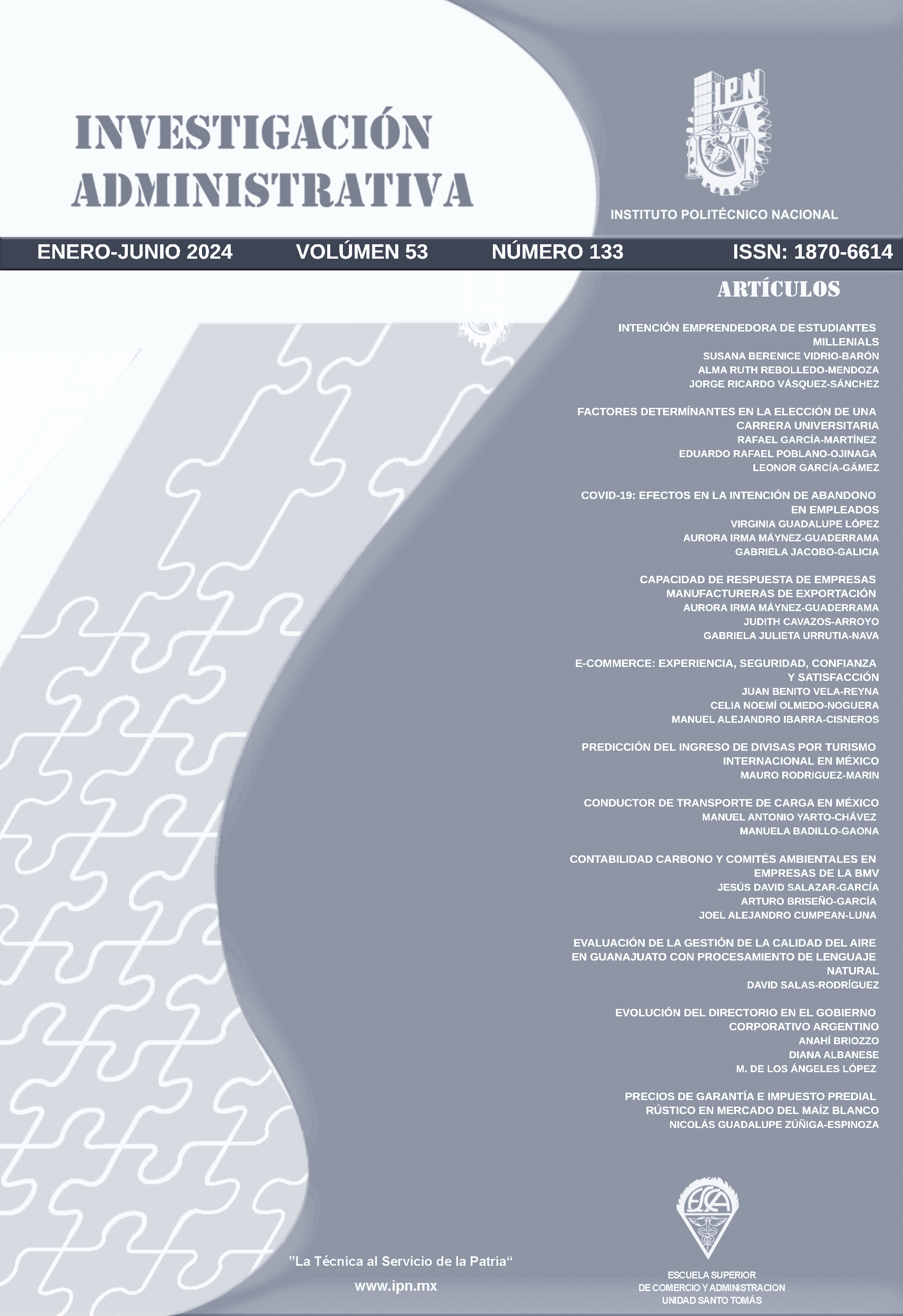Currency Prediction Income from International Tourism in Mexico
Main Article Content
Abstract
The objective is to understand how international tourism has contributed to the Mexican economy and to predict its future development, considering the impact of global events and travel trends. A quantitative research method is employed, using the ARIMA model to analyze and project income from international tourism. Data from 2010 to 2023, obtained from BANXICO, are analyzed. The results show a seasonal pattern in income, with notable growth from 2014 until before the pandemic. A significant recovery is anticipated from 2023, with an increase of 17.4% in the first half compared to 2022. The findings indicate that the ARIMA (1,1,2) (1,1,0) model is the most suitable for predicting income from international tourism in Mexico. Continuous growth in foreign exchange income is projected until 2026.
The originality of this study lies in its focus on international tourism as a key source of foreign exchange income for Mexico, using an advanced predictive model and considering the impact of recent global events.
The limitations include the inherent uncertainty in long-term projections and the reliance on historical patterns and trends, which may not capture future structural changes. The conclusions show that international tourism is a vital economic engine for Mexico, with a sustained growth trend. The ARIMA model provides an effective tool for predicting future income, crucial for strategic planning in the tourism sector. However, it is essential to consider the limitations of the model and the need for periodic updates to adapt to changes in the global environment.
Article Details

This work is licensed under a Creative Commons Attribution-NonCommercial 4.0 International License.
References
Aguiló, P. M., et al. (2001). Determinants of the price of German tourist packages on the island of Mallorca. Tourism Economics.
Akaike, H. (1974). A new look at the statistical model identification. IEEE Transactions on Automatic Control, 19(6), 716-723.
Ascanio, A., Mendoza, A. H., & JL, C. (1996). Evaluación de la demanda turística internacional hacia Venezuela. Estudios y Perspectivas en Turismo, 5(2).
Athanasopoulos, G., Hyndman, R. J., Song, H., & Wu, D. C. (2011). The tourism forecasting competition. International Journal of Forecasting, 27(3), 822-844.
Box, G. E. P., & Jenkins, G. M. (1970). Time Series Analysis: Forecasting and Control. Holden Day.
Chacaltana, J. (1999). El turismo en el Perú: Perspectivas de crecimiento y generación de empleo (No. E12 O33 No. 102-S). Oficina Internacional del Trabajo.
Chatfield, C., & Xing, H. (2019). The analysis of time series: An introduction with R. CRC Press. https://doi.org/10.1201/9781351259446
Claveria, O., & Torra, S. (2014). Forecasting tourism demand to Catalonia: Neural networks vs. time series models. Economic Modelling, 36, 220-228.
Conde Gaxiola, N. (2013). Análisis de la llegada de turistas internacionales a México. Investigación Administrativa del IPN, 111, 20-24.
DATATUR. (n.d.). Llegadas de Turistas por residencia. Recuperado de https://www.datatur.sectur.gob.mx/SitePages/Visitantes%20por%20Residencia.aspx
Esteban, T. A. (1996). El marketing turístico: La orientación de la actividad hacia el consumidor. Civitas.
Fish, M., & Gibbons, J. (1991). Mexico's devaluations and changes in net foreign exchange receipts from tourism. International Journal of Hospitality Management, 10, 73-80. https://doi.org/10.1016/0278-4319(91)90008-6.
Gardella, R., & Aguayo, E. (2002). Impacto económico del turismo en el Mercosur y Chile (1990-2000). Estudios Económicos de Desarrollo Internacional, 2(1).
Hao, F., Xiao, Q., & Chon, K. (2020). COVID-19 and China's hotel industry: Impacts, a disaster management framework, and post-pandemic agenda. International Journal of Hospitality Management, 90, 102636.
Jud, G. D., & Joseph, H. (1974). International demand for Latin American tourism. Growth and Change, 5(1), 25-31.
Makoni, T., Mazuruse, G., & Nyagadza, B. (2023). International tourist arrivals modelling and forecasting: A case of Zimbabwe. Sustainable Technology and Entrepreneurship, 2(1), 100027.
Mishra, P. K., et al. (2018). Seasonality in tourism and forecasting foreign tourist arrivals in India. Iranian Journal of Management Studies (IJMS), 11(4), 629-658.
Mohamed, N., Bakar, M. A., Razali, S. N. M., Mazlan, N. K., Idrus, N., Aleng, N. A., & Yusof, Y. (2023, October). Tourism forecasting using box-Jenkins SARIMA and artificial neural network (ANN) models: Case for outbound and inbound tourist in Malaysia. En AIP Conference Proceedings (Vol. 2746, No. 1). AIP Publishing. https://doi.org/10.1063/5.0168806
Ponterio, V. S. (1991). Metodología en el Turismo. Trillas.
Porto, N. (1999). El turismo como alternativa de crecimiento. Documentos de Trabajo.
Rivas-Tovar L. A. (2023). Normas Apa 7ª Edición: Estructura,
Robano, V. (2000). Determinantes del turismo receptivo en Uruguay. En Proceedings of the XV Jornadas de Economía del Banco Central del Uruguay.
Rodriguez-Marin, M. (2023). Demanda de turistas internacionales hacia México: Construcción de un modelo predictivo. Contaduría y Administración, 69(4). http://dx.doi.org/10.22201/fca.24488410e.2024.5092
Sánchez López, F. (2022). Measuring the effect of the misery index on international tourist departures: Empirical evidence from Mexico. Economies, 10(4), 81.
Shumway, R. H., & Stoffer, D. S. (2017). ARIMA models. En Time Series Analysis and Its Applications: With R Examples (pp. 75-163).
Song, H., & Witt, S. (2000). Tourism demand modelling and forecasting: Modern econometric approaches. Pergamon.
Song, H., & Li, G. (2008). Tourism demand modelling and forecasting—A review of recent research. Tourism Management, 29(2), 203-220. https://doi.org/10.1016/j.tourman.2007.07.016
Venables, W. N., & Smith, D. M. (2003). The R development core team. An Introduction to R, Version 1(0).
Wu, D. C. W., Ji, L., He, K., & Tso, K. F. G. (2021). Forecasting tourist daily arrivals with a hybrid Sarima–Lstm approach. Journal of Hospitality & Tourism Research, 45(1), 52-67.

